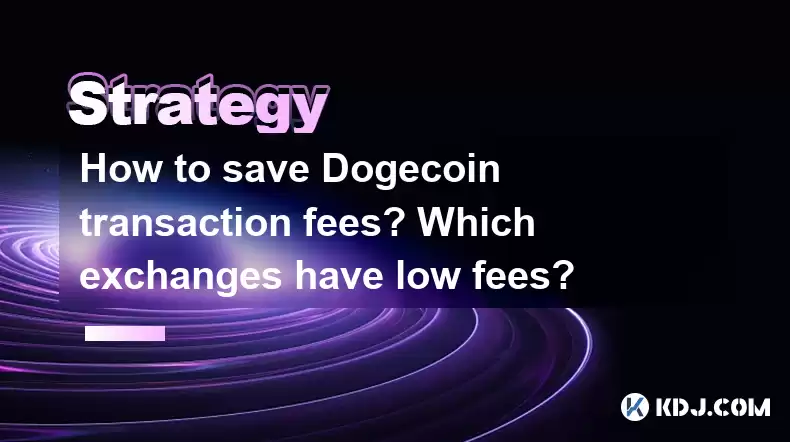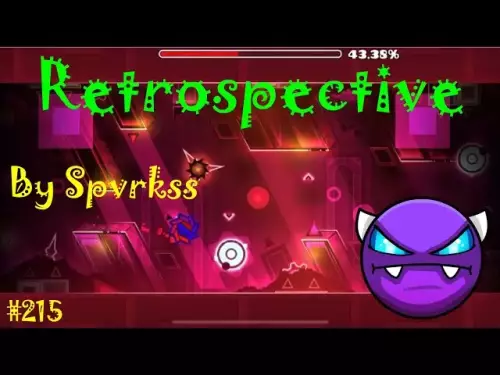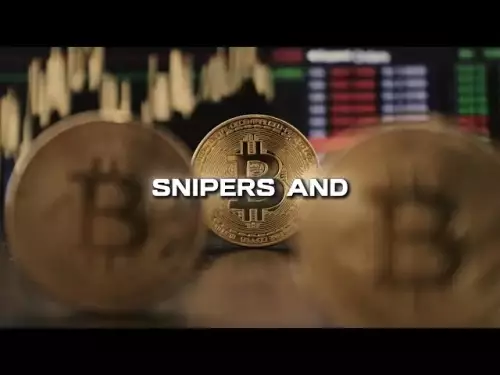-
 bitcoin
bitcoin $108183.343957 USD
1.12% -
 ethereum
ethereum $3953.318181 USD
2.13% -
 tether
tether $1.000758 USD
0.05% -
 bnb
bnb $1102.411872 USD
1.73% -
 xrp
xrp $2.377410 USD
1.30% -
 solana
solana $185.715867 USD
0.05% -
 usd-coin
usd-coin $1.000561 USD
0.08% -
 tron
tron $0.320859 USD
2.39% -
 dogecoin
dogecoin $0.194561 USD
3.07% -
 cardano
cardano $0.647327 USD
2.68% -
 hyperliquid
hyperliquid $37.310392 USD
1.96% -
 ethena-usde
ethena-usde $0.999792 USD
0.04% -
 chainlink
chainlink $17.181017 USD
2.56% -
 stellar
stellar $0.316938 USD
1.13% -
 bitcoin-cash
bitcoin-cash $472.186880 USD
1.35%
How to save Dogecoin transaction fees? Which exchanges have low fees?
To minimize Dogecoin transaction fees, batch transactions, use SegWit wallets, and choose exchanges like Binance or Kraken for lower costs.
Apr 29, 2025 at 04:43 am

Understanding Dogecoin Transaction Fees
Dogecoin, a popular cryptocurrency known for its community and tipping culture, often comes with transaction fees that can impact the overall cost of using the network. Transaction fees are charges that users pay to have their transactions processed and included in the Dogecoin blockchain. The fee amount can vary based on network congestion and the priority given to the transaction.
To save on Dogecoin transaction fees, it's essential to understand how these fees are calculated and what factors influence them. The primary factors affecting Dogecoin transaction fees include the size of the transaction in bytes, the level of network congestion, and the priority you set for your transaction. Typically, a higher fee results in faster transaction processing, while a lower fee might lead to longer wait times.
Strategies to Minimize Dogecoin Transaction Fees
There are several strategies you can employ to minimize the fees you pay for Dogecoin transactions. One effective approach is to batch your transactions. Instead of sending multiple small transactions, you can combine them into a single larger transaction, which can reduce the overall fee. This is particularly useful if you're sending Dogecoin to multiple recipients.
Another strategy involves setting the transaction fee manually. Most wallets allow you to customize the fee, so you can choose a lower fee if you're willing to wait longer for your transaction to be processed. However, be cautious not to set the fee too low, as this might result in your transaction being stuck in the mempool.
Using a wallet that supports SegWit can also help reduce fees. SegWit, or Segregated Witness, is a protocol upgrade that optimizes the way data is stored in transactions, leading to lower fees. By using a SegWit-enabled wallet, you can enjoy reduced transaction costs without compromising on security or speed.
Exchanges with Low Dogecoin Transaction Fees
Choosing the right exchange can significantly impact the fees you pay for Dogecoin transactions. Some exchanges are known for their competitive fee structures, making them ideal for users looking to save on costs. Here are a few exchanges that typically offer low fees for Dogecoin transactions:
Binance: Binance is known for its low trading fees, which can be as low as 0.1% per trade. For Dogecoin withdrawals, the fee is typically around 1 DOGE per transaction, which is relatively low compared to other platforms.
Kraken: Kraken offers competitive fees for Dogecoin transactions, with withdrawal fees around 2 DOGE. Additionally, their trading fees can be as low as 0.16% for makers and 0.26% for takers, depending on your trading volume.
Coinbase: Coinbase charges a flat fee of $0.99 for Dogecoin withdrawals up to $10, with higher fees for larger amounts. Their trading fees are around 0.50% for most users, but can be reduced with higher trading volumes.
KuCoin: KuCoin offers low trading fees starting at 0.1% and withdrawal fees for Dogecoin around 1 DOGE. This makes it another cost-effective option for Dogecoin transactions.
When choosing an exchange, consider not only the transaction fees but also the overall user experience, security features, and the availability of other cryptocurrencies you might be interested in trading.
How to Set Up a Dogecoin Wallet with Low Fees
Setting up a Dogecoin wallet that supports low fees involves a few key steps. Here's how you can do it:
Choose a SegWit-Enabled Wallet: Start by selecting a wallet that supports SegWit. Popular options include Dogecoin Core, Exodus, and Electrum-DOGE. These wallets are known for their support of SegWit, which can help reduce transaction fees.
Download and Install the Wallet: Visit the official website of the wallet you've chosen and download the software. Follow the installation instructions to set up the wallet on your device.
Create a New Wallet: Once the wallet is installed, create a new wallet by following the on-screen prompts. Make sure to securely store your recovery phrase, as this will be crucial for recovering your wallet if needed.
Configure Transaction Fees: Most wallets allow you to set custom transaction fees. Navigate to the settings or transaction section of your wallet and adjust the fee to a lower amount if you're willing to wait longer for your transaction to be processed.
Send and Receive Dogecoin: With your wallet set up and configured, you can now start sending and receiving Dogecoin. Always double-check the recipient's address and the transaction details before confirming.
Tips for Managing Dogecoin Transaction Fees
In addition to the strategies mentioned above, here are some additional tips for managing Dogecoin transaction fees effectively:
Monitor Network Congestion: Keep an eye on the Dogecoin network's congestion levels. During times of high congestion, fees may be higher, so it might be wise to wait for a less busy period to send your transactions.
Use a Fee Estimator: Some wallets and online tools provide fee estimators that can help you determine the optimal fee for your transaction. These tools take into account current network conditions and can help you set a fee that balances speed and cost.
Avoid Peak Times: If possible, avoid sending transactions during peak times, such as when there's a lot of market activity or during major Dogecoin events. Fees tend to be lower during off-peak hours.
Consider Using a Hardware Wallet: While not directly related to transaction fees, using a hardware wallet like Ledger or Trezor can enhance your overall security and peace of mind when dealing with cryptocurrencies.
Frequently Asked Questions
Q1: Can I use Dogecoin for everyday transactions without incurring high fees?Yes, you can use Dogecoin for everyday transactions with minimal fees by employing the strategies outlined above, such as batching transactions, using SegWit-enabled wallets, and choosing the right time to send your transactions.
Q2: Are there any Dogecoin wallets that automatically optimize transaction fees?Some wallets, such as Dogecoin Core and Electrum-DOGE, offer features that can help optimize transaction fees based on current network conditions. These wallets may automatically adjust fees to balance speed and cost.
Q3: How do I know if a Dogecoin exchange is reputable and safe?To determine if a Dogecoin exchange is reputable and safe, look for exchanges that are well-established, have strong security measures in place (such as two-factor authentication and cold storage), and have positive user reviews. Additionally, check if the exchange is regulated and compliant with local laws.
Q4: Can I reduce Dogecoin transaction fees by using a different blockchain?No, Dogecoin transaction fees are specific to the Dogecoin blockchain and cannot be reduced by using a different blockchain. However, you can use the strategies mentioned in this article to minimize fees within the Dogecoin network.
Disclaimer:info@kdj.com
The information provided is not trading advice. kdj.com does not assume any responsibility for any investments made based on the information provided in this article. Cryptocurrencies are highly volatile and it is highly recommended that you invest with caution after thorough research!
If you believe that the content used on this website infringes your copyright, please contact us immediately (info@kdj.com) and we will delete it promptly.
- Floki, Elon Musk, and the Memecoin Rally: A Wild Ride
- 2025-10-21 04:45:14
- Pumpfun (PUMP) and the Memecoin Mania: Riding the Wave Like a New Yorker
- 2025-10-21 04:25:12
- Injective ETF Buzz: SEC Approval and Institutional Demand Heat Up!
- 2025-10-21 04:45:14
- Elon Musk, Floki Inu, and a Price Rally: What's the Hype?
- 2025-10-21 04:25:12
- Web3, Privacy, and AI: Navigating the Decentralized Frontier in 2025
- 2025-10-21 04:30:01
- PENGU Price, Prediction, and Breakout Zone: What's the Buzz?
- 2025-10-21 04:50:01
Related knowledge

Practical parameter settings for a Bitcoin multi-timeframe moving average system
Sep 18,2025 at 10:54pm
Optimizing Timeframe Combinations for Bitcoin Trading1. Selecting appropriate timeframes is crucial when building a multi-timeframe moving average sys...

How can I filter out false breakouts in Dogecoin high-frequency trading?
Sep 22,2025 at 01:00am
Understanding False Breakouts in Dogecoin Trading1. A false breakout occurs when Dogecoin's price appears to move beyond a defined support or resistan...

Techniques for identifying tops and bottoms in the Bitcoin on-chain NVT model
Sep 20,2025 at 07:54pm
Understanding the NVT Model in Bitcoin Analysis1. The Network Value to Transactions (NVT) ratio is often described as the 'P/E ratio' of the cryptocur...

What does the surge in open interest in Bitcoincoin futures mean?
Sep 20,2025 at 11:18pm
Understanding the Surge in Dogecoin Futures Open Interest1. A surge in open interest within Dogecoin futures indicates a growing number of active cont...

How can I use the Ethereum USDT premium to gauge market sentiment?
Sep 18,2025 at 11:55pm
Understanding the Ethereum USDT Premium1. The Ethereum USDT premium refers to the price difference between USDT (Tether) traded on Ethereum-based plat...

What should I do if Ethereum staking yields decline?
Sep 20,2025 at 06:18am
Understanding the Causes Behind Declining Ethereum Staking Yields1. The Ethereum network transitioned to a proof-of-stake consensus mechanism with the...

Practical parameter settings for a Bitcoin multi-timeframe moving average system
Sep 18,2025 at 10:54pm
Optimizing Timeframe Combinations for Bitcoin Trading1. Selecting appropriate timeframes is crucial when building a multi-timeframe moving average sys...

How can I filter out false breakouts in Dogecoin high-frequency trading?
Sep 22,2025 at 01:00am
Understanding False Breakouts in Dogecoin Trading1. A false breakout occurs when Dogecoin's price appears to move beyond a defined support or resistan...

Techniques for identifying tops and bottoms in the Bitcoin on-chain NVT model
Sep 20,2025 at 07:54pm
Understanding the NVT Model in Bitcoin Analysis1. The Network Value to Transactions (NVT) ratio is often described as the 'P/E ratio' of the cryptocur...

What does the surge in open interest in Bitcoincoin futures mean?
Sep 20,2025 at 11:18pm
Understanding the Surge in Dogecoin Futures Open Interest1. A surge in open interest within Dogecoin futures indicates a growing number of active cont...

How can I use the Ethereum USDT premium to gauge market sentiment?
Sep 18,2025 at 11:55pm
Understanding the Ethereum USDT Premium1. The Ethereum USDT premium refers to the price difference between USDT (Tether) traded on Ethereum-based plat...

What should I do if Ethereum staking yields decline?
Sep 20,2025 at 06:18am
Understanding the Causes Behind Declining Ethereum Staking Yields1. The Ethereum network transitioned to a proof-of-stake consensus mechanism with the...
See all articles










































































